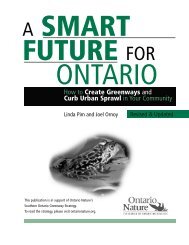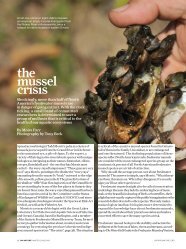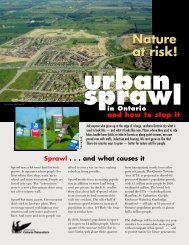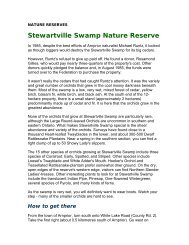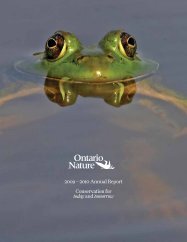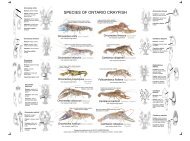The Green Way Forward - Ontario Nature
The Green Way Forward - Ontario Nature
The Green Way Forward - Ontario Nature
You also want an ePaper? Increase the reach of your titles
YUMPU automatically turns print PDFs into web optimized ePapers that Google loves.
<strong>The</strong> <strong>Green</strong> <strong>Way</strong> <strong>Forward</strong><br />
A Review of Natural Heritage Policies for Southern <strong>Ontario</strong><br />
<strong>Ontario</strong> <strong>Nature</strong>, 2009
Acknowledgements<br />
<strong>Ontario</strong> <strong>Nature</strong> gratefully acknowledges the assistance of the following people who provided<br />
invaluable information, insight and perspective on natural heritage policy issues: Ian Attridge,<br />
John Bacher, Gregor Beck, Trevor Bingler, Alison Chapman, Debbe Crandall, David Donnelly,<br />
Victor Doyle, Hannah Evans, Nathan Fahey, Elaine Farragher, Yvonne Fernandes, Natalie<br />
Helferty, Steve Hounsell, Louisette Lanteigne, Anne Lewis, Don McLean, Daphne Nicholls, Ken<br />
Petersen, Linda Pim, Sarah Powell, Kevin Rich, Joyce Sankey, George Tashos, John Taylor, Neil<br />
Taylor, Stuart Thatcher, Jason Thorne, Ken Whitbread, Mark Winfield and Michael Wynia. Note,<br />
however, that the views presented in this paper represent those of <strong>Ontario</strong> <strong>Nature</strong> and do not<br />
necessarily reflect those of the aforementioned individuals. A special thanks to Wendy Francis<br />
for her leadership on the project.<br />
<strong>The</strong> production of this paper was made possible thanks to the generous support of the George<br />
Cedric Metcalf Foundation.<br />
Project Concept: Wendy Francis<br />
Writer: Andrea Smith<br />
Editors: Gregor Beck, Anne Bell, Amber Cowie, Victoria Foote<br />
Editorial Assistance: Gail Narine, Alexis Wood<br />
Design: Levi Nicholson<br />
Copyright © 2009 <strong>Ontario</strong> <strong>Nature</strong> – Federation of <strong>Ontario</strong> Naturalists<br />
3 <strong>The</strong> <strong>Green</strong> <strong>Way</strong> <strong>Forward</strong> A Review of Natural Heritage Policies for Southern <strong>Ontario</strong>
Executive Summary<br />
Dramatic changes have occurred across much of <strong>Ontario</strong>’s natural landscape over the last<br />
two centuries. In that time, land has been cleared for agriculture, urban settlement, roads and<br />
industry. In southern <strong>Ontario</strong>, the result is a patchwork of small, isolated and fragmented natural<br />
areas within a sea of development and modified landscapes. As well, polluted air, water and<br />
soils have affected the health of people, wildlife and ecosystems. Overall, the rich diversity of<br />
the province’s plant and animal life has been greatly diminished.<br />
In recent years, the significance of southern <strong>Ontario</strong>’s natural heritage has received greater<br />
attention from the public and various levels of government. A number of positive policy changes<br />
and new conservation initiatives have been developed, refined and implemented. Such<br />
advances are encouraging, but these efforts remain largely piecemeal, uncoordinated and<br />
inadequate to protect nature against the insidious creep of urban sprawl and the continued loss<br />
of wetland, woodland and grassland habitats in some parts of the rural landscape. Current<br />
policies are failing to maintain and restore important “core” natural areas and ecologically<br />
essential lands and waterways that connect core areas, and function as “corridors.”<br />
4 <strong>The</strong> <strong>Green</strong> <strong>Way</strong> <strong>Forward</strong> A Review of Natural Heritage Policies for Southern <strong>Ontario</strong>
To better protect and restore the province’s natural heritage, <strong>Ontario</strong> <strong>Nature</strong> envisions a<br />
<strong>Green</strong>way for southern <strong>Ontario</strong>, made up of a network of interconnected natural cores and<br />
corridors. This <strong>Green</strong>way would protect natural features and systems, protect water quality<br />
and quantity, improve air and soil quality, protect and restore habitat for native wildlife and<br />
species at risk, enhance human health and well-being and, critically, enable adaptation to the<br />
anticipated impacts of climate change.<br />
In this paper, <strong>Ontario</strong> <strong>Nature</strong> reviews and critiques current provincial policies aimed at natural<br />
heritage protection in southern <strong>Ontario</strong> relating to planning and development, aggregate extraction,<br />
environmental assessment, conservation of biodiversity, and provincial land use plans. With<br />
respect to each policy we review key components, identify shortcomings that weaken natural<br />
heritage protection and present recommendations to improve their effectiveness. We put<br />
forward 24 recommendations, many addressing overlapping issues. Of pressing concern<br />
are five systemic problems underlying these issues:<br />
1. <strong>The</strong> lack of an effective, system-based approach to natural heritage planning and protection<br />
2 . <strong>The</strong> lack of monitoring of <strong>Ontario</strong>’s large-scale land use plans<br />
3 . Insufficient constraints on infrastructure development in policies intended to protect natural<br />
heritage values<br />
4. Insufficient constraints on aggregate extraction in policies intended to protect natural<br />
heritage values<br />
5 . <strong>The</strong> lack of inter-ministerial coordination in developing and implementing policies to protect<br />
natural heritage features and systems<br />
5 <strong>The</strong> <strong>Green</strong> <strong>Way</strong> <strong>Forward</strong> A Review of Natural Heritage Policies for Southern <strong>Ontario</strong>
If <strong>Ontario</strong>’s natural heritage is to be afforded adequate protection based on sound science<br />
and integrated policy, these systemic problems must be addressed in accordance with the<br />
following overarching recommendations:<br />
1.Establish a system-based approach to natural heritage protection<br />
and planning.<br />
To make this happen, collaboration among differing levels of government and all ministries<br />
involved in land use planning is required to streamline protection, ensure that efforts are not<br />
duplicated and provide support to municipalities doing the lion’s share of the work on the ground.<br />
This paper cites numerous examples of obstacles to a system-based approach, but none is as<br />
pressing or all encompassing as the changes that are needed to the Provincial Policy Statement,<br />
2005. <strong>The</strong> Provincial Policy Statement makes reference to the need for a system-based<br />
approach to natural heritage protection but, due to weak language, lack of clear requirements<br />
and inadequate assistance for municipalities, it fails to deliver. Standards for natural<br />
heritage system development, clear requirements for protection and support for municipalities<br />
are needed to ensure that the Provincial Policy Statement can meet its stated goals.<br />
2. Monitor the effectiveness of all large-scale land use plans.<br />
Without a clear set of indicators to assess the implementation of complex plans such as the<br />
<strong>Green</strong>belt Plan, it is difficult to know whether policy goals are being achieved. <strong>The</strong> lack of<br />
measurable results has undermined adaptive management and the ability to improve policies<br />
or procedures that need refinement. All provincial land use plans should identify clear, measurable<br />
indicators and outcomes related to natural heritage features and systems, and should<br />
require monitoring and assessment at regularly scheduled intervals, ideally immediately<br />
before plans are up for review.<br />
6 <strong>The</strong> <strong>Green</strong> <strong>Way</strong> <strong>Forward</strong> A Review of Natural Heritage Policies for Southern <strong>Ontario</strong>
3. Assess, control and prevent the negative impacts of infrastructure<br />
development on natural heritage.<br />
Infrastructure development has too often been seen as inevitable for growth and has thus been<br />
exempted from policy measures intended to protect natural heritage values. For example,<br />
the privileging of infrastructure development over the protection of natural heritage features in<br />
the Oak Ridges Moraine Conservation Plan has undermined efforts to protect waterways,<br />
forests and wetlands in the region. If infrastructure continues to be approved with few or no<br />
constraints, then hope for a healthy, resilient natural heritage system in southern <strong>Ontario</strong> is<br />
severely compromised. <strong>The</strong> Province must seek and implement solutions that allow for<br />
development to occur without the careless destruction of natural systems.<br />
4. Assert tighter controls on aggregate extraction and develop an integrated<br />
plan for aggregate conservation and site rehabilitation.<br />
In many instances, aggregate development trumps provincial, regional and municipal protection<br />
of natural heritage features. For example, aggregate extraction is ongoing in the Niagara<br />
Escarpment and has not slowed even with the implementation of the <strong>Green</strong>belt Plan.<br />
Provincial policy does not require demonstration of the need for aggregate extraction before<br />
development proposals are approved, and, consequently, aggregate extraction is treated<br />
as inevitable and unstoppable. <strong>The</strong> Province must develop a comprehensive aggregate<br />
conservation and site rehabilitation strategy to promote the substitution, reduction, reuse and<br />
recycling of aggregate resources; the improved rehabilitation of sites; a detailed analysis of<br />
future supply and demand; and the identification of priority areas for resource extraction that<br />
do not conflict with other land use considerations.<br />
5. Integrate natural heritage protection into the operations and policies of all<br />
ministries involved in land use planning and environmental protection.<br />
To be effective, the protection of natural heritage in <strong>Ontario</strong> must be better coordinated among<br />
relevant ministries. For example, <strong>Ontario</strong>’s Biodiversity Strategy (MNR, 2005) should be integrated<br />
with the Provincial Policy Statement, the Growth Plan for the Greater Golden Horseshoe and<br />
<strong>Ontario</strong>’s Action Plan on Climate Change so that all plans include specific elements to protect<br />
biodiversity through land use planning and growth management initiatives. Effective land use<br />
planning, protection of biodiversity and adaptation to climate change require the collaboration<br />
and cooperation of all relevant ministries.<br />
7 <strong>The</strong> <strong>Green</strong> <strong>Way</strong> <strong>Forward</strong> A Review of Natural Heritage Policies for Southern <strong>Ontario</strong>
<strong>Ontario</strong> can no longer afford – in either the economic or the ecological sense – to continue with<br />
a piecemeal approach to natural heritage protection. Systemic problems, such as those<br />
described above, must be addressed. As the province’s human population expands, and with<br />
the advent of climate change, we require policy direction that is comprehensive, integrated and<br />
accountable.<br />
We cannot meet the challenges ahead unless policies are founded on the understanding that<br />
nature is an integrated system in which all elements must be healthy and connected to ensure<br />
that the whole will thrive. For this reason, <strong>Ontario</strong> <strong>Nature</strong> is advocating policy reform that will<br />
support a <strong>Green</strong>way of interconnected natural cores and corridors across all of southern and<br />
eastern <strong>Ontario</strong>.<br />
8 <strong>The</strong> <strong>Green</strong> <strong>Way</strong> <strong>Forward</strong> A Review of Natural Heritage Policies for Southern <strong>Ontario</strong>
<strong>Ontario</strong> <strong>Nature</strong> gratefully acknowledges the support of the George Cedric<br />
Metcalf Foundation in the production of <strong>The</strong> <strong>Green</strong> <strong>Way</strong> <strong>Forward</strong>.



